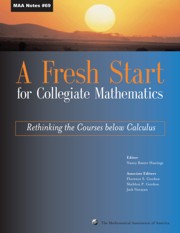Book contents
- Frontmatter
- Preface
- Contents
- Introduction
- Background
- Theme 1 New Visions for Introductory Collegiate Mathematics
- Theme 2 The Transition from High School to College
- Theme 3 The Needs of Other Disciplines
- Theme 4 Student Learning and Research
- Theme 5 Implementation
- Theme 6 Influencing the Mathematics Community
- Ideas and Projects that Work: Part 1
- Ideas and Projects that Work: Part 2
- 35 Mathematics in Action: Empowering Students with Introductory and Intermediate College Mathematics
- 36 Precalculus: Concepts in Context
- 37 Rethinking College Algebra
- 38 From The Bottom Up
- 39 The Functioning in the Real World Project
- 40 The Importance of a Story Line: Functions as Models of Change
- 41 Using a Guided-Inquiry Approach to Enhance Student Learning in Precalculus
- 42 Maricopa Mathematics
- 43 College Algebra/Quantitative Reasoning at the University of Massachusetts, Boston
- 44 Developmental Algebra: The First Mathematics Course for Many College Students
- 45 Workshop Precalculus: Functions, Data, and Models
- 46 Contemporary College Algebra
- 47 Precalculus: A Study of Functions and Their Applications,
- 48 Success and Failures of a Precalculus Reform Project
36 - Precalculus: Concepts in Context
from Ideas and Projects that Work: Part 2
- Frontmatter
- Preface
- Contents
- Introduction
- Background
- Theme 1 New Visions for Introductory Collegiate Mathematics
- Theme 2 The Transition from High School to College
- Theme 3 The Needs of Other Disciplines
- Theme 4 Student Learning and Research
- Theme 5 Implementation
- Theme 6 Influencing the Mathematics Community
- Ideas and Projects that Work: Part 1
- Ideas and Projects that Work: Part 2
- 35 Mathematics in Action: Empowering Students with Introductory and Intermediate College Mathematics
- 36 Precalculus: Concepts in Context
- 37 Rethinking College Algebra
- 38 From The Bottom Up
- 39 The Functioning in the Real World Project
- 40 The Importance of a Story Line: Functions as Models of Change
- 41 Using a Guided-Inquiry Approach to Enhance Student Learning in Precalculus
- 42 Maricopa Mathematics
- 43 College Algebra/Quantitative Reasoning at the University of Massachusetts, Boston
- 44 Developmental Algebra: The First Mathematics Course for Many College Students
- 45 Workshop Precalculus: Functions, Data, and Models
- 46 Contemporary College Algebra
- 47 Precalculus: A Study of Functions and Their Applications,
- 48 Success and Failures of a Precalculus Reform Project
Summary
Precalculus: Concepts in Context [1] was developed in response to calculus reform and to the authors' general dissatisfaction with results in traditional precalculus courses. Believing that traditional precalculus instruction failed to prepare students for reform calculus (and we would argue, for traditional calculus as well), Judy Moran, Mary Murphy and I set out to reform precalculus with the publication of a laboratory manual, Precalculus in Context: Functioning in the Real World [2]. The lab manual was designed to supplement a standard precalculus course by providing opportunities for students to work collaboratively on lengthy, context-based problems. However, we soon discovered that the supplement was more powerful than the course it was meant to serve. During labs, students were actively grappling with mathematical problems from real-world contexts and they were learning to think, speak, and write mathematics. Furthermore, by listening to their discussions, we learned much about what students really understood or failed to understand. As a result, our more global fix for precalculus, Precalculus: Concepts in Context, was a combined text and lab/project manual. The text portion was unusual in that it used a mathematical modeling approach and required students to interact with the text during reading (there are fill-ins within the text).
In writing the second edition, we have changed neither our original goals nor our strategies for achieving those goals. Our major goal has been to make the text more student and instructor friendly. Key points are summarized in the margins for easy reference.
- Type
- Chapter
- Information
- A Fresh Start for Collegiate MathematicsRethinking the Courses below Calculus, pp. 337 - 340Publisher: Mathematical Association of AmericaPrint publication year: 2006



